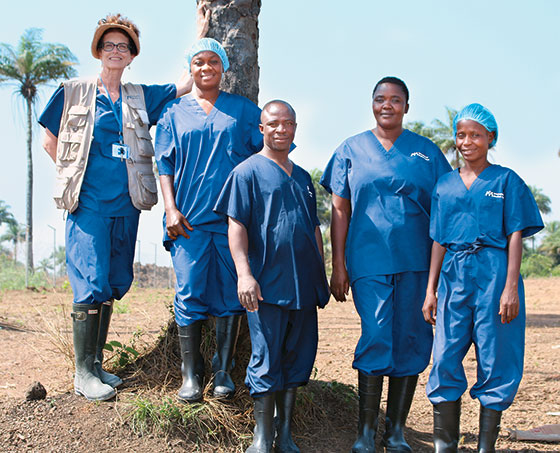 |
Dr. Ramona Sunderwirth, far left, in Sierra Leone.
(Photo: Samantha Ryder/International Medical Corps) |
Most doctors can’t just drop everything and volunteer in Africa. But New York has sent 14 brave souls through the two major volunteer groups, Doctors Without Borders and the International Medical Corps. That number might have been higher except that both groups have been especially choosy about who gets to go. More than half of the 70 American DWB volunteers had worked with the group before; others, like Craig Spencer, went through a rigorous screening process to gauge their ability to handle the physical and emotional toll. After they’re accepted, they all undergo training either stateside in Alabama or abroad in Switzerland or Belgium. “And once they hit the ground in Africa, they do a separate five-day training,” says Margaret Aguirre of IMC, which has sent 40 doctors to help fight Ebola. “They have to get used to the rooms, the flow of patients.”
Ramona Sunderwirth, a doctor at St. Luke’s–Roosevelt, made it through the IMC interviews thanks to her experience working at a bustling urban ER. (She had also volunteered at a refugee camp in Macedonia after the 1999 Kosovo crisis.) In early November, she left behind her husband in Harlem and six adult children and headed to Sierra Leone. “Of course I was afraid,” she says. “I think anyone who is not afraid to work in an Ebola treatment center shouldn’t be there.”
Nothing tests Sunderwirth’s composure like the treatment tents. Outside, it’s 100 degrees; inside, wearing protective gear, it’s closer to 120. Her pace, as she treats patients, is glacial—“almost like meditation,” she says—each interaction interrupted by the spraying of a chlorine solution on any body part that touches anything else. Often there is only enough time for two or three discrete tasks—swabbing an arm, applying a tourniquet, inserting an IV, drawing blood—before she runs out of stamina. And then there is the bleak fact that nearly half of her patients will die. “There were people around me in the morning who looked okay and a couple of hours later were dead.”
But she can’t help being hopeful. Sunderwirth treated one spunky 15-year-old girl who would demand rice, then pepper soup, then rice pudding, then eggs, and then refuse to eat any of it. She eventually moved to the bed next to a 14-year-old boy whose father died of Ebola and whose uncle now has it. The boy and the girl have bonded and are getting better. “The nurses are positive this is going to be Love in the Time of Ebola,” she says. “I hope so.”